Stern Pinball brings the legendary assassin to the world of mechanical gaming.
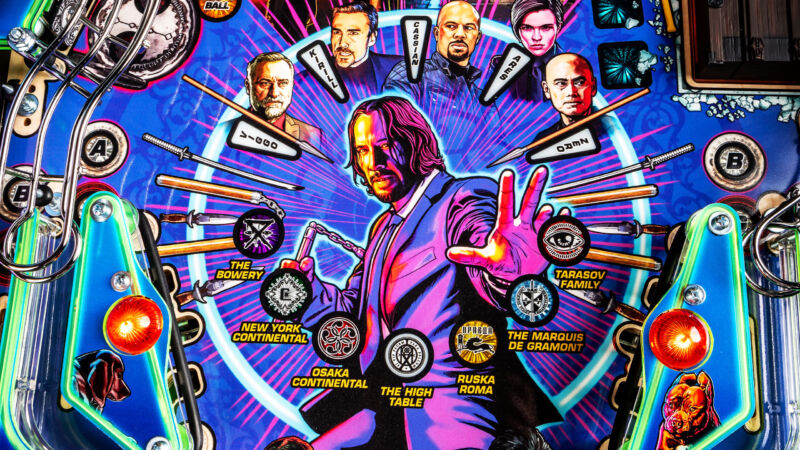
If you don’t follow the ins and outs of pinball, you might be surprised to find out there are more active companies making games in 2024 than ever before.
Stern Pinball is the 800-pound gorilla of the industry. It has been around the longest, has the largest factory, sells the most games, and releases more titles per year than anyone else. For years, it was the sole remaining pinball company in the world.
Now—despite the decline of arcades—pinball is seeing a second life. A passionate collector base dedicates entire game rooms in their homes to machines. Pinball and bars go together so well Stern has a whole video series on “brewcade hopping”. There are games in comics shops. One of my more amazing local spots is in the back of a Korean BBQ. All this interest has created a thriving pinball ecosystem of boutique makers, where success is often measured in sales of 1,000 machines or fewer. Other pinball companies might not compete with Stern directly by volume, but they do provide a level of competition for ideas that keeps the hobby strong.
An incomplete overview of the landscape
Stern’s latest release is John Wick, and we’ll get to my hands-on impressions shortly. Another semi-recent title from Stern I’m very fond of and wouldn’t mind owning is Godzilla.
Recent notable first-time boutique releases include Pulp Fiction from Play Mechanix/Chicago Gaming Company and Labyrinth from Barrels of Fun. More established indie companies like Spooky Pinball have done games like Scooby Doo, Texas Chainsaw Massacre, and Halloween. Jersey Jack Pinball has led the charge in the ridiculously expensive category, with games like Elton John and The Godfather including eye-watering $15,000 limited editions.Advertisement
Full disclosure: I was the art director on Alien from Pinball Brothers, and I recently finished a new Ellen Ripley package for it and contributed art to the company’s new ABBA title.
Multimorphic, a company that makes games that are a hybrid of physical pinball and an interactive LCD playfield, recently released the Princess Bride and Weird Al.
You may be noticing a trend here: many licensed entertainment titles and a lot of ’70s and ’80s nostalgia. It’s what sells to an older collector base. Even Pulp Fiction, which is a ’90s film, is built to look like an early ’80s game, complete with alphanumeric displays and a simpler playfield layout.
Among all these older licenses and small runs of games, Stern stands out. While it isn’t immune to the nostalgia factor either—it recently released Jaws—it also traffics in more modern licenses like Stranger Things or The Mandalorian.
The company’s brand-new game, John Wick, is refreshingly current. The fourth film in the Keanu Reeves assassin franchise only came out last year. Licenses are a reality of the industry; it’s what sells, but it’s nice to see something that doesn’t feel aimed squarely at the 40-and-up crowd’s youthful memories (yes, I’m a member of that group).
I got some hands-on time with the Premium version of the game and an interview with Stern’s marketing director (and world-class pinball player), Zach Sharpe. The following are my initial impressions mixed with bits from our talk.
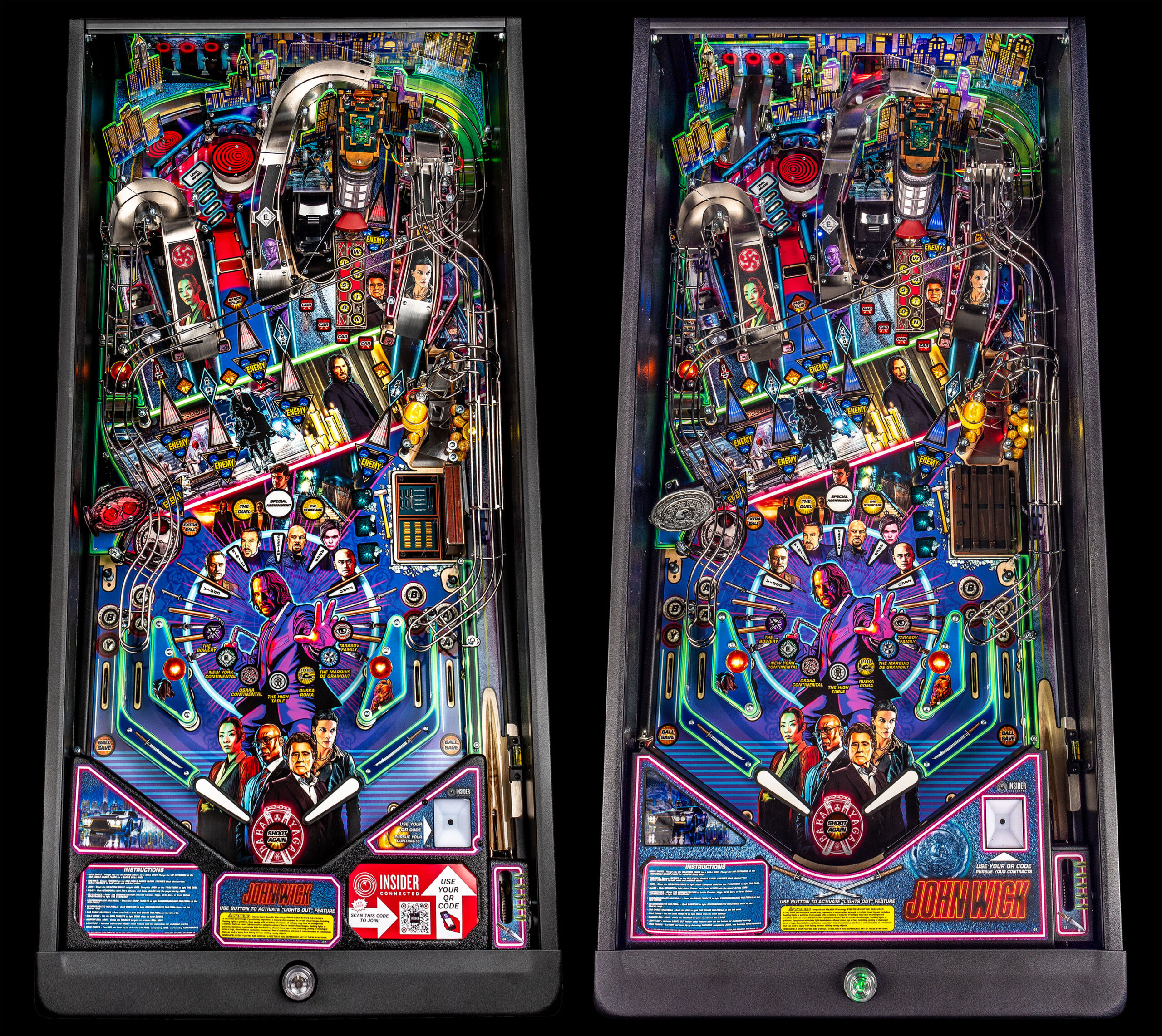
ARS VIDEO
What Happens to the Developers When AI Can Code? | Ars Frontiers
Good evening, Mr. Wick
First off, the pin is a looker. Pop culture illustrator Randy Martinez (who also did The Mandalorian pinball art) did a fantastic job of capturing the neon noir vibe. It can be challenging to bring a darker feel to pinball, which the body count-soaked John Wick calls for, while still keeping things bright and appropriate for dimly lit rooms. I think he nailed it.
The playfield layout is by first-time designer Elliot Eismin, who has been a mechanical engineer with Stern for around 10 years. This is his first time controlling the game’s flow instead of supporting someone else’s vision, and his design offers a nice combination of smooth shooting and mechanics that interact with the ball. Stern has been giving more opportunities to new designers in recent years, and I’m a big fan of the new ideas.
I’m always interested in mechanical elements that change the flow of the game or have multiple uses, and this has several. Wick’s muscle car acts as a bash toy but can also swing out to block a lane. This provides a nice double function by giving you a different angle to shoot at from below at the flippers, as well as being able to trap a ball coming down from above so the game can release it on its own timing.
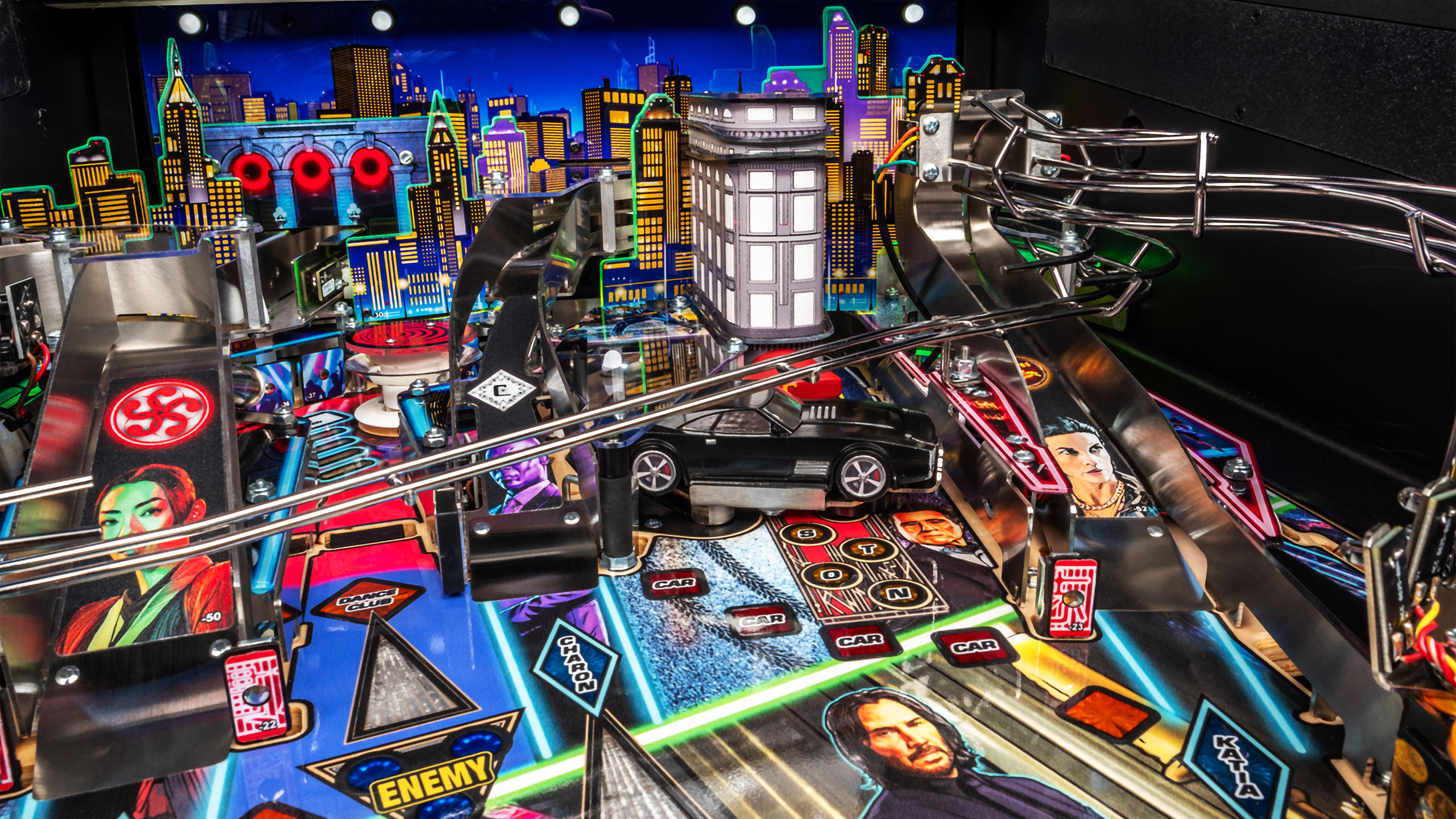
There’s a weapon chest on the right side, which also has a dual function as a target and as an object that flips up to reveal access to a scoop, which you can shoot from the left flipper or soft plunge into at the start of a new ball.
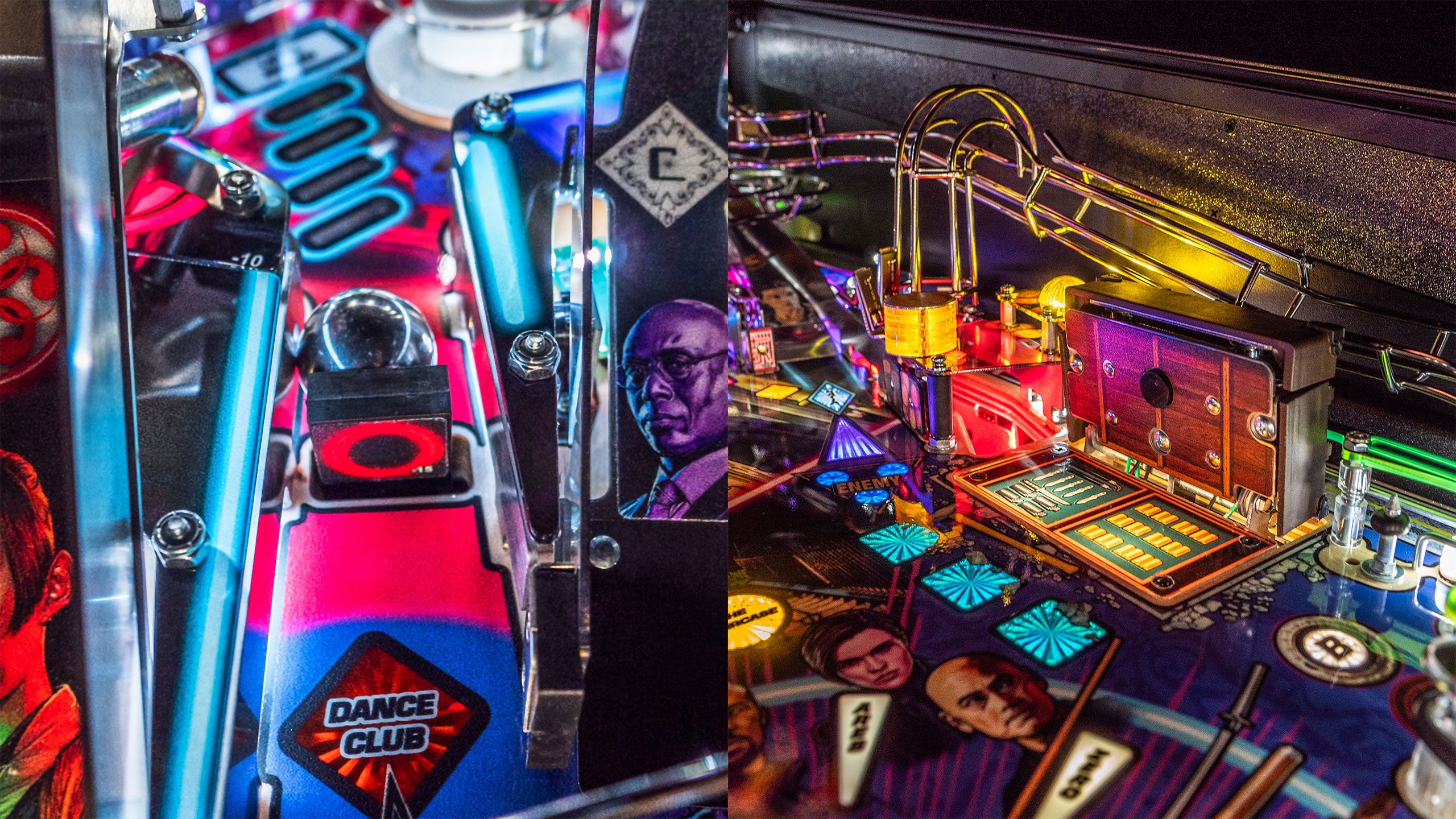
The blood oath marker mounted on the left side is a nice touch that doesn’t interact with the ball. Stern had access to one of the original movie prop coins and digitally scanned it to re-create it. During gameplay, it flips open to reveal two light-up red fingerprints; it’s a great callout to the films.
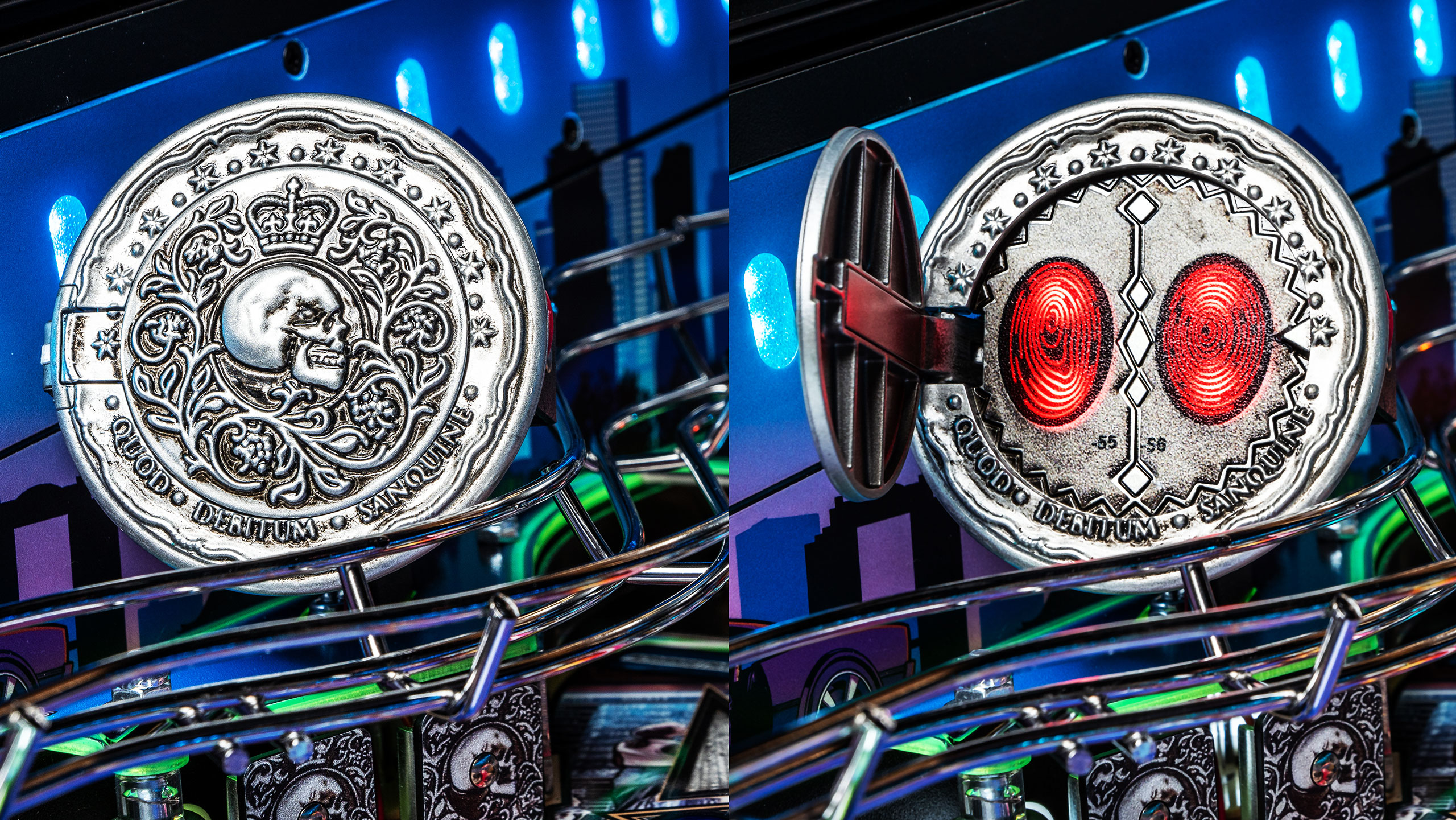
I only had around 30 minutes of playtime, which is not nearly enough to really dig into the game’s rules. But one feature that Sharpe and the company are particularly proud of is a dynamic difficulty system that adjusts the number of enemies (represented by the lit inserts on the playfield) you’re trying to defeat based on how well you’re playing. As you defeat more at a time, the movie clips in the backbox’s LCD screen change to reflect the number you just took out. It’s a nice touch, and a level of attention to detail that I appreciate.
Another notable feature is the game’s narration from Ian McShane, who plays The Continental Hotel owner Winston in the films. But if you’re anything like me you’re a fan because of his incredible (and incredibly explicit) performances in HBO’s Deadwood. His voice adds a perfect gravitas to the gameplay.
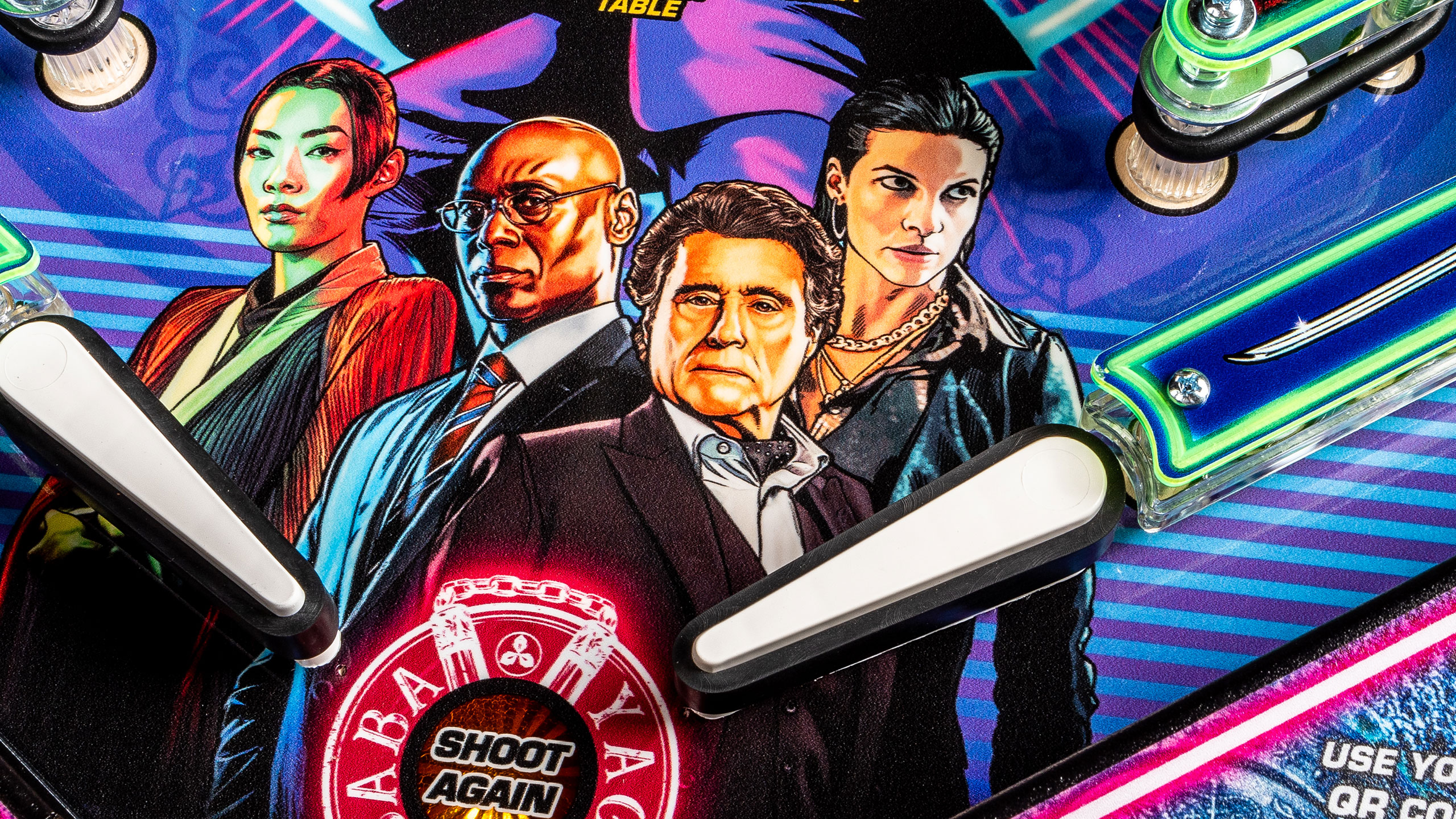
The challenge with making new pinball games is keeping the classic physicality of the game, the satisfying feeling of the metal ball flying around the playfield while doing enough new things not to feel like you’ve seen it all before. This game hits a nice sweet spot without doing anything super inventive. The metal ramps, wireforms, and lanes feel good to shoot. It’s a fast game; I lost the ball more than once while trying to split my attention between talking and playing, and it demands a certain level of concentration. The mechanical features that change shots, including a drop target that can pop up to block a lane, add a nice level of dynamic decision-making.
The license is well-integrated. Good art that isn’t just a cut-and-paste from movie posters, original callouts from an actor with a great voice, and, while you’re probably going to be too busy keeping the ball from draining to pay too much attention to the LCD screen, the movie clips and on-screen elements look good.
I will note just one funny thing about the use of the film setting. Look at the playfield and the cabinet and you’ll notice a conspicuous lack of guns. Lots of swords and spears and nunchucks! This doesn’t bother me—I imagine Lionsgate made it a condition of the license, given that it will possibly be in family-friendly gaming locations, but it is a bit of an omission of the film’s subject matter.
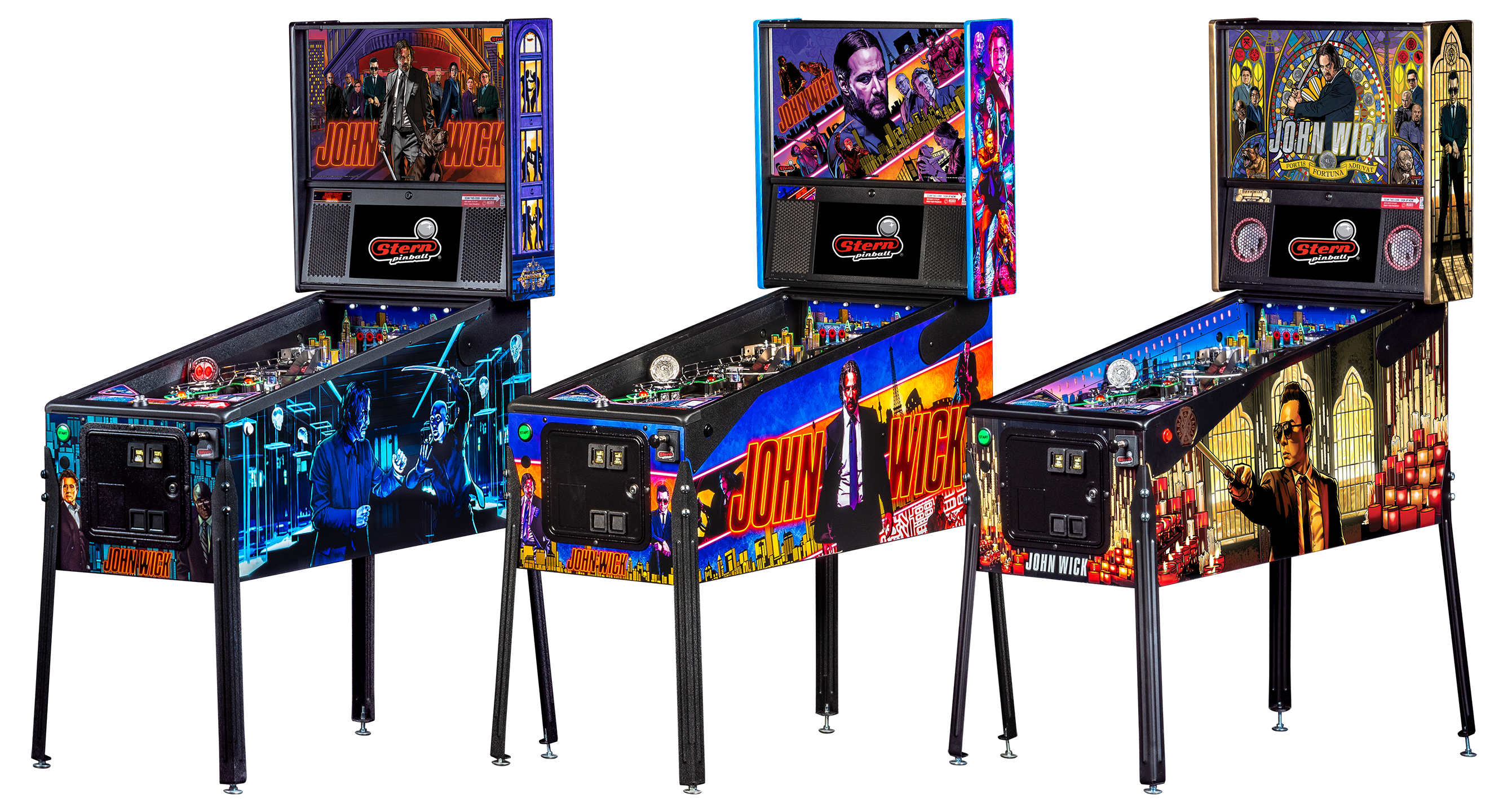
You keen on earning a coin?
Pinball is not a cheap hobby, and John Wick is no exception. The Pro model, which includes less interactive elements, sells for $6,999. The Premium model I played is $9,699, and you’ll shell out $12,999 if you want the Limited Edition, complete with a piece of a suit used in the films, along with other bells and whistles like mirrored ink on the backglass.
Despite those prices, Sharpe told me Stern has seen 15–25 percent growth year over year for more than the last decade. He said, “It’s been nearly impossible for us to keep up with demand.” They moved into a larger factory last year that is almost twice the size of the previous one. He couldn’t break down what percent goes to private collectors versus other vendors, but my sense is that collectors drive the hobby’s growth and keep it alive.Advertisement
All game versions come with Stern’s Insider Connected, which lets you connect your game to Wi-Fi and log in using a QR code and a camera embedded in the apron. This enables features like automatic leaderboards and console-like achievements. For John Wick, Stern is adding a series of “contract” events, which will be limited-time goals. I’ve never personally cared much about achievements in games, but I know they’re popular with some people, and it’s a smart way to keep people engaged. I will say it is fun to show up to a location and see a TV with a real-time leaderboard. You can look for your friends, or try and get on it yourself. It adds a nice touch to that old-school arcade feeling of putting your initials in.
Having worked on a pinball game, I can tell you it’s a labor of love; these games take a lot of effort to make. Even Stern, with all its years of experience and industry-leading factory, spends around two years to develop a game. It’s not uncommon for smaller companies and teams to spend three years or more. It’s an industry populated by people who really love the industry. Stern, despite being a big company comparatively, is no different; the care it puts in is obvious.
Despite the crazy prices and all the work, the hobby is clearly thriving, and as a player, I couldn’t be happier with our wealth of choices. I highly recommend hitting up Pinball Map and seeing if you have any games on location near you. And when one of my nearby spots gets John Wick I’m looking forward to going back for some more games myself.
The teaser trailer for the game is short on actual gameplay but will give you a taste of the game in motion and the overall vibes.




